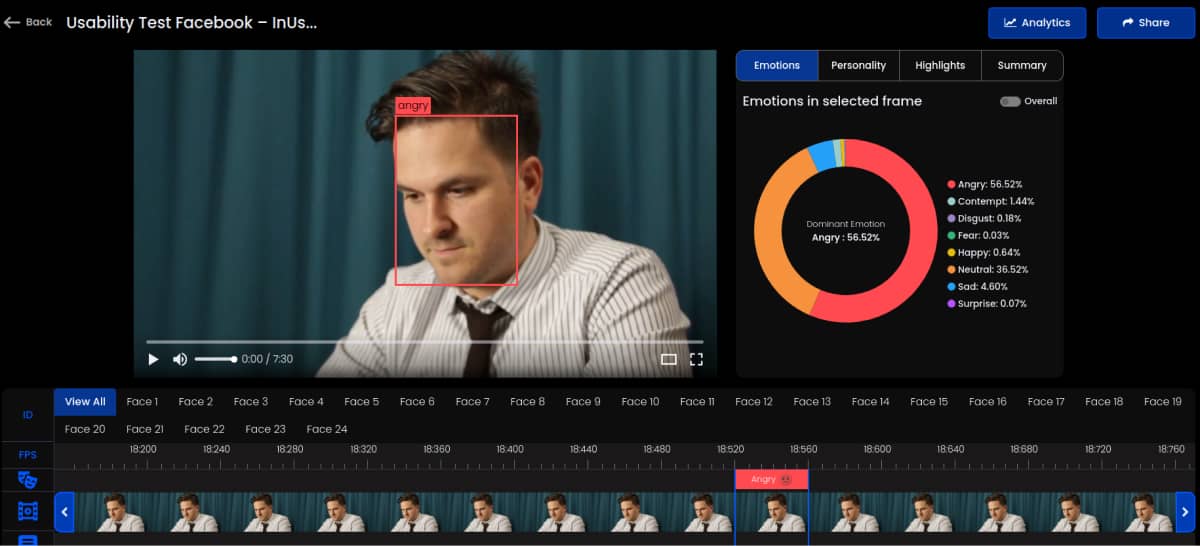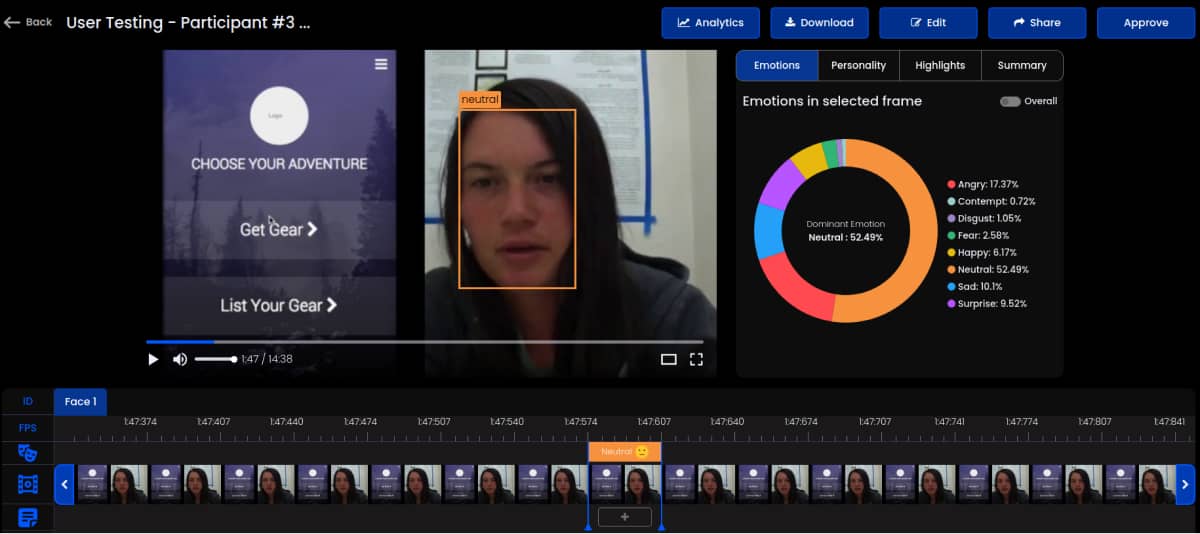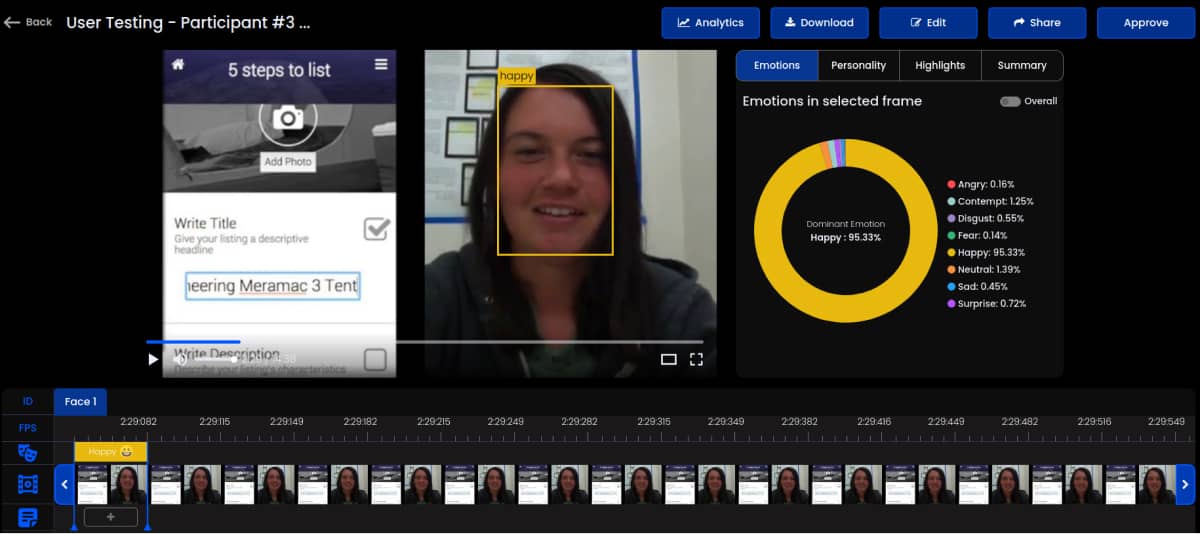
Exploring Emotion Patterns in User Testing with Emotion AI
Understanding user psychology is essential for creating products and experiences that meet users' needs, desires, and expectations. The most effective way to understand user psychology is through comprehensive user research, including surveys, interviews, usability testing, and data analysis. Analyzing (recognizing) user emotions during testing provides authentic insights, allowing UX Researchers and Product Managers to customize products and experiences to meet user expectations effectively.
Recognizing facial emotions provides authentic insights into user experiences. They go beyond verbal feedback, revealing users' genuine emotions, preferences, and pain points. This *emotional data is invaluable for enhancing user satisfaction, refining the user journey, and creating (digital) products that resonate with users on a deeper level.

Traditional methods often rely on explicit feedback, but users may not always articulate their emotions. Emotion AI, with its advanced *facial detection and recognition capabilities, decodes subtle facial expressions, providing a nuanced understanding of users' genuine emotions. This fills a crucial gap, ensuring a more comprehensive and accurate assessment of user experiences.
In parallel, acknowledging the impact of emotions on user experiences is crucial. Emotions are pivotal in shaping cognitive functions such as perception, attention, memory, and decision-making. This understanding is vital for crafting user experiences that seamlessly connect with users, fostering engagement at a deeper emotional level.
Within test sessions, user emotions subtly influence the questions posed, allowing us to analyze *emotional responses and gain valuable insights into the nuanced aspects of user interactions.

Let's explore examples from a Facebook user testing session, where the participant faced challenges in understanding privacy settings, successfully created a friend list after searching on Google, and experienced confusion while trying to find a post in the created list. These instances provide insights into user emotions, interactions, and potential areas for improvement in the digital environment.
In this user testing scenario, where privacy and participant comfort are prioritized, the facilitator maintains a relaxed atmosphere, guiding the discussion with task-related questions.

The participant, while sharing feedback about the unaccomplished initial task, expresses a sense of emptiness. The open and supportive setting encourages genuine exploration of the user's feelings and responses during the tasks.
We then conducted an *emotional analysis of this user test recording using our Emotion AI software, Imentiv AI technology. Here are the invaluable psychological insights gained:
Neutral Facial Expression: The participant's mostly neutral facial expression suggests a lack of strong emotions. This neutrality could be due to factors like a disconnection from the task, familiarity with similar interfaces, or a focus on task completion over expressing emotions.
Combination of Neutral to Negative Emotions on the Emotion Wheel : The mix of neutral to negative emotions, leaning towards confusion, indicates the participant's struggle to understand the privacy settings. Even though the outward expression is neutral, underlying negative feelings like frustration may be present, contributing to the overall emotional state.

Cognitive Load and Confusion: Difficulty in changing privacy settings likely adds cognitive load, leading to confusion. This might result in a neutral facial expression as the participant processes information and tries to solve problems, yet harbors underlying negative emotions due to the challenge.
User Experience Frustration: Negative emotions, especially related to confusion, suggest a suboptimal user experience with Facebook's privacy settings. This frustration can impact satisfaction, potentially causing disengagement or reluctance to use the privacy features.
Usability Issues and Design Considerations: The neutral to negative emotional response highlights potential usability issues, emphasizing the need for user-centered design. Conducting further usability testing and iterative improvements can enhance the interface, improving user experience and reducing confusion.
The *psychological analysis unveils that although the participant's facial expression seems neutral, underlying emotions of confusion and frustration signal usability challenges in navigating Facebook's privacy settings.
Integrating *Video Emotion Recognition Technology or Emotion AI Software to detect and analyze these nuanced emotional cues can provide valuable insights for enhancing design and conducting usability testing. By addressing these concerns proactively, businesses can improve user experience, mitigate negative emotional responses, and foster a more positive interaction environment.
In another testing scenario, the facilitator guides the participant through a usability test for a surfboard website that facilitates the exchange of outdoor gear, allowing users to both rent and offer gear for rent. The participant smoothly accomplished the first task, listing their tent for rent.

However, during the second task of renting a tent for their camping trip, the participant faced some challenges but succeeded, in expressing satisfaction. The facilitator engaged in follow-up questions to understand moments of frustration, confusion, and expectations, eliciting valuable feedback from the participant about her user experience in navigating the platform for renting and listing outdoor gear.
Examining the psychological aspects of this user testing video with Emotion AI technologies like Imentiv AI offers valuable insights into the participant's cognitive and emotional processes throughout the test. When observing the participant's facial expressions, the predominant neutrality suggests a focused and emotionally stable state, emphasizing task concentration.
Instances of transitioning from neutral to happy emotions may indicate moments of success, satisfaction, or clarity during the test. This *emotional shift could result from understanding a task, completing it, or discovering features aligned with the participant's expectations.
On the other hand, transitions from neutral to negative emotions, particularly linked to confusion, highlight *cognitive challenges or frustrations encountered during the test. This could stem from unexpected interfaces, unclear instructions, or functionality misaligned with participant expectations, indicating potential areas for improvement.
The combination of neutral, happy, and negative emotions reflects a dynamic emotional experience, showcasing participant engagement with different aspects of the interface. This emotional spectrum provides valuable feedback for UX designers, indicating areas for enhancement, particularly in addressing confusion or frustration to improve overall user satisfaction.
It's crucial to consider individual differences, recognizing that participants may vary in their emotional expressions based on unique backgrounds and preferences. Therefore, a nuanced understanding of each participant's emotional responses offers valuable insights into their distinct user experience journey.
Breaking Down Theories Based on Analyzed Video
In the context of the video we've examined, two key theories shed light on the cognitive and emotional shifts observed during user testing. Let's explore these theories to understand better how participants navigate their experiences:
Cognitive Dissonance Theory: This theory helps explain transitions from neutral to negative emotions when users face confusing or conflicting elements in the interface. Participants may feel discomfort due to conflicting beliefs, resulting in negative emotions during the testing process.
Flow Theory: Examining shifts from neutral to positive emotions, Flow Theory comes into play during moments of success, satisfaction, or clarity in the user test. This theory describes an optimal experience where users are fully immersed and engaged, often experienced when overcoming challenges within the interface.
These theories offer a straightforward framework to comprehend the cognitive and emotional dynamics of participants, focusing on the challenges and satisfactions encountered while interacting with the video-analyzed interface.
It's worth noting that the design of websites, apps, and even tangible products plays a big part in how users feel. Whether it's a digital service or a physical product when it creates restrictions, requires users to change their plans, or demands extra attention, it can lead to some frustration or annoyance.
Exploring the emotion analysis of two user testing videos with Imentiv AI, an Emotion AI software, offers a profound understanding of design and user experience, guided by Don Norman's three design levels—visceral, behavioral, and reflective.
Visceral Level: In those crucial first moments on a website, immediate impressions form based on aesthetics—the visceral level. How the design makes one feel is key.

The emotion analysis tool decodes these initial emotional responses, providing insights beyond what is seen to understand how the design evokes emotions.
Behavioral Level: Throughout the user's journey on a website, the behavioral level unfolds with real-time experiences, including frustrations and delights. This aligns with Norman's perspective on ongoing user interactions.

Leveraging the emotion analysis tool offers a backstage pass to these nuanced emotions, enabling refinement and enhancement of the user's journey.
Reflective Level: Beyond the visit, reflection on the experience occurs—the reflective level. The emotion analysis tool becomes a guide, helping analyze emotional responses throughout the entire interaction. This provides a unique perspective to craft a website that lingers positively in thoughts.
As we consider the impact of this understanding, it seamlessly aligns with strategies for user testing and, by extension, customer retention. Gauging or analyzing user emotions while surfing through the website in user testing is crucial for comprehending the impact of the websites/products being created and fostering lasting connections with users.
Moving forward, leverage this unique perspective (Emotion AI technology) to not only attract but also retain customers through emotionally resonant design.
GLOSSARY:
*Facial detection refers to the technology used to identify the presence of a human face in a digital image or video.
*Facial recognition aims to identify or verify a specific individual's face from a digital image or video.
*Emotional data includes information revealing emotions, expressed through words, non-verbal cues (e.g., emojis, voice tone, facial expressions), or even physiological responses (e.g., heart rate).
*Emotional responses are the physiological, behavioral, and cognitive reactions individuals experience in response to internal and external stimuli. They encompass a complex interplay between the brain, body, and environment.
*Emotional analysis is the process of identifying and understanding the emotions expressed in various data sources, such as text, speech, facial expressions, or physiological data.
*Psychological analysis is the process of exploring and interpreting an individual's mental state, personality, and behavior within a psychological framework.
*Video Emotion Recognition Technology refers to a specific type of artificial intelligence (AI) that analyzes video data to automatically detect and classify the emotions of individuals depicted in the footage.
*Emotional shift is a change in an individual's emotions, from sudden bursts of joy to anger, or a gradual transition from frustration to acceptance. These shifts can be triggered by internal thoughts or external events.
*Cognitive challenges refer to difficulties or obstacles encountered in mental processes such as learning, memory, problem-solving, or decision-making.